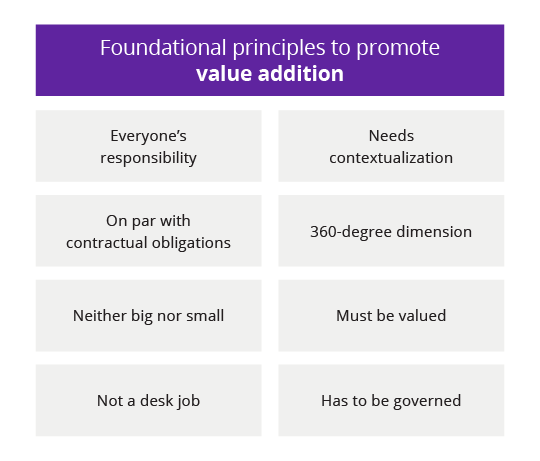In brief
- Establishing a value addition culture in an IT vendor organization presents challenges, but can be achieved through strategic principles.
- Key principles to promote value addition adoption include shared responsibility for all team members, fostering creative thinking, and implementing a robust governance framework.
- Adaptix's 8 principles for software delivery can benefit both IT vendor organizations and their clients.
In software delivery, value addition occurs when an IT vendor goes beyond contractual
obligations to provide additional business benefit.
Value addition should be the
bedrock of IT vendor culture. However, an IT vendor organization looking to establish a
value addition culture faces several challenges:

Here are eight major principles that can help you promote the adoption of value addition:

1. Value addition is everyone’s responsibility
Often, it’s assumed that value addition is a responsibility of specific roles such
as:
- Senior members with the relevant subject matter expertise
- Dedicated transformation leads and their teams
The creation of value addition initiatives is not solely down to senior members or dedicated transformation leads. It’s a vital task shared by everyone in the team, including less-experienced members and joiners with evolving knowledge. Value addition culture needs to be embedded throughout the delivery structure.
2. Value needs context
Value addition needs to be clearly defined for applicable areas of an engagement. The
context might need to be aligned with:
- Client’s business objectives
- IT vendor organization objectives
- Software applications in scope
- Domain and technology specializations
- Industry best practices
- Client culture
Cultural acceptance might require the introduction of a harmonization exercise to establish common ground across all sectors involved. Contextualization provides clearly defined focus areas for idea generation and helps address the “No definition syndrome”, and any cultural gaps.
3. Value addition should be on par with contractual obligations
Value addition must be awarded the same importance as delivery goals and
contractual obligations. Key actions:
- Regard value addition as part of the project scope
- Execute value addition initiatives with the same rigor as core delivery projects
- Establish value addition thinking in all aspects of software development across each life cycle stage, from project scoping to post-production support
- Incorporate detailed value addition and delivery planning for overall project scope
- Adopt an Agile approach by establishing a consistent feedback loop with all stakeholders, including the IT vendor organization and client, to validate the ideas
These practices ensure a structured approach for generating value, gaining an assurance of capacity and helping to meet contractual obligations. In addition, they address the triple challenge of structural gaps, scarcity of capacity and treating the contract as the sole guide.
4. Value in the round
Value addition has a 360-degree dimension and needs to be considered in the round for the benefit of all stakeholders. This holistic approach promotes transparency in the interests of all members of the supply chain, enhancing trust and delivering significant business value for each client. It can be enabled by consistently measuring the ROI from the value addition initiative to the IT vendor’s teams, third parties and clients.
5. Value is neither big nor small
Value creation is not determined by weight of impact. Every idea must be
respected and encouraged regardless of its likely effect.
- Enable a “No idea is rejected” policy. Maintain a backlog of ideas and a regular review program
- Group ideas according to their level of impact — individual, team, project, department, organization and so on. Resources might be deployed in proportion to the idea’s level of impact, but nothing should be ignored
- Publish all successfully implemented ideas to all stakeholders, acknowledging the value of every idea irrespective of impact
- Establish mentorship programs to encourage teams to see the bigger picture, potentially exploring the benefits of even the most insignificant ideas
6. Value addition must be valued
When, in their vision statement, an IT vendor promotes the idea that the concept
of value addition is valuable in itself, the commitment creates organization-wide
excitement. Here are some other ways to honor the practice of value addition:
- Establish incentivization schemes
- Ensure the fair, objective and transparent assessment of promotional ideas
- Publish successfully implemented ideas right across the enterprise
- Encourage teams to share best practices
- Assign a tangible or intangible value to every idea to highlight outcomes achieved post implementation
7. Value addition is not a desk job
The best ideas are rarely generated sitting at a desk. The process requires
creative stimulation and blue-sky thinking. Key best practices:
- Train teams on idea generation techniques such as fishbone diagrams, mind mapping and similar methodologies
- Conduct “Creative Hour” or “Shoot the Idea” sessions to provide a supportive environment where team members are not afraid to share ideas
- Secure specific phases of the project cycle to implement creative ideas (as recommended by SAFe Agile standards)
- Encourage SMEs to act as mentors to help team members with creative thinking
- Let teams see the real-life application of their developed software, so they can empathize with users and identify possible value-addition opportunities
8. Value addition has to be governed
That said, best practice alone might not generate value. IT vendors need to
establish a robust governance framework to track progress and ensure success. This
includes:
- Establishing a transparent governance process to prioritize ideas
- Tracking progress and including status updates in reviews with senior executives
- Establishing transparent KPIs to measure success
- Enabling organization-wide communications around the success of these initiatives via online dashboards, emails and town halls
In other words, value addition is a critical success factor for the business growth of both IT vendor organizations and their clients. And it needs a scientific approach for promotion and execution.







